Radiometric, Mechanical and Agronomic Characterization of Four Commercial Polymeric Films for Greenhouse Applications
Abstract
:1. Introduction
2. Materials and Methods
2.1. Radiometric Properties
2.2. Mechanical Properties
2.3. Film Behavior under Semi-Field Conditions
2.4. Statistical Analysis
3. Results
3.1. Radiometric Properties
3.2. Mechanical Properties
3.2.1. Tensile Test
3.2.2. Dart Impact Test
3.3. Evaluation of Environmental Factors in the Field
3.3.1. Photosynthetically Active Radiation (PAR)
3.3.2. Temperature
3.3.3. Relative Humidity
4. Discussion
4.1. Radiometric Properties
4.2. Mechanical Properties
4.3. Evaluation of Environmental Factors in the Field
5. Conclusions
Author Contributions
Funding
Data Availability Statement
Conflicts of Interest
References
- González Argandar, C. Evaluación Agronómica de Películas para Invernadero Formuladas con Nanoparticulas de Óxido de Zinc. Ph.D. Thesis, Centro de Investigación en Química Aplicada, Saltillo, Mexico, 2010. [Google Scholar]
- Orden, S.; Goldberg, M.; Quartino, R.; Mascarini, L.; Landini, A.; Malleville, H.; Bottini, L. Estudio comparativo entre ensayos de exposición natural y envejecimiento acelerado de films de polietilenos para invernaderos. Agric. Téc. 2000, 60, 295–304. [Google Scholar] [CrossRef]
- Franco, J.E.; Rodríguez-Arroyo, J.A.; Ortiz, I.M.; Sánchez-Soto, P.J.; Garzón, E.; Lao, M.T. Chemical, Radiometric and Mechanical Characterization of Commercial Polymeric Films for Greenhouse Applications. Materials 2022, 15, 5532. [Google Scholar] [CrossRef] [PubMed]
- Palma Pérez, A. Evaluación de las Propiedades Ópticas y Mecánicas de Diferentes Cubiertas Plásticas de Invernadero. Ph.D. Thesis, Universidad Autónoma Agraria Antonio Narro, Saltillo, Mexico, 2009. [Google Scholar]
- Del Ángel-Hernandez, M.; Zermeño-Gonzalez, A.; Melendres-Alvarez, A.; Campos-Magaña, S.; Cadena-Zapata, M.; Bosque-Villareal, G. Características de la cubierta de un túnel efecto en radiación, clorofila y rendimiento de calabacita. Rev. Mex. Cienc. Agrícolas 2017, 8, 1127–1142. [Google Scholar]
- Waaijenberg, D. Design, construction and maintenance of greenhouse structures. Acta Hortic. 2006, 710, 31–42. [Google Scholar] [CrossRef]
- Díaz Serrano, T. Plásticos, cubiertas a medida para invernaderos. Rev. Hortic. 2000, 1, 138–143. [Google Scholar]
- Escrig Rondan, C. Extrusión de Film Soplado; AIMPLAS Instituto Tecnológico del Plástico: Valencia, Spain, 2018. [Google Scholar]
- Godoy Arias, D.H. Análisis de Películas Utilizadas en Invernadero. Ph.D. Thesis, Escuela Politécnica Superior del Litoral, Guayaquil, Ecuador, 2007. [Google Scholar]
- Ruiz, P.; Sanders, B.; Vulic, I.; Zenner, J. Estabilización ultravioleta de películas de invernadero, experiencia de un proveedor de aditivos. In Proceedings of the V Congreso Iberoamericano para el Desarrollo y Aplicación de Plásticos en la Agricultura (CIDAPA 2004), Bogota, Colombia, 8–10 November 2004; pp. 55–62. [Google Scholar]
- Martínez Ramírez, J.N. Uso de Diferentes Cubiertas Plásticas en Invernadero para Mejorar los Efectos de Radiación, Temperatura y Humedad Relativa. Ph.D. Thesis, Centro de Investigación en Química Aplicada, Saltillo, Mexico, 2008. [Google Scholar]
- Espí, E.; Salmeron, A.; Garcia, Y.; Catalina, F. Pigmentos de inferencia como modificadores del espectro de transmisión de filmes agrícolas. Rev. Plásticos Mod. 2002, 83, 50–56. [Google Scholar]
- Ordaz Baldera, J.F. Estudio Sobre Películas Plásticas para Invernadero. Ph.D. Thesis, Centro de Investigación en Química Aplicada, Saltillo, Mexico, 2007. [Google Scholar]
- Ventura González, M. Transformación de Materiales Plásticos por Extrusión; AIMPLAS Instituto Tecnológico del Plástico: Valencia, Spain, 2002. [Google Scholar]
- Pillajo Sinailin, J.P. Evaluación de la Incorporación de un Masterbatch con Efecto Antitérmico en las Propiedades de Películas Sopladas de Polietileno de baja Densidad. Ph.D. Thesis, Escuela Politécnica Nacional, Quito, Ecuador, 2017. [Google Scholar]
- Hemming, S. Materiales difusos para cubiertas de invernadero no solamente para climas cálidos. Rev. Plast. 2008, 127, 25–39. [Google Scholar]
- Guzmán, P.M. Respuesta Fisiológica y Control Ambiental; Instituto Nacional de Capacitación para la Productividad Agrícola (INCAPA, S.C): Guadalajara, Mexico, 2000. [Google Scholar]
- Serope, K.; Steven, R.S. Manufacturing, Engineering and Technology, 4th ed.; Prentice-Hall Inc.: Upper Saddle River, NJ, USA, 2002. [Google Scholar]
- Shackelford, J.F. Introduction Materials Science for Engineers, 7th ed.; Library of Congress Cataloging Publication: Washington, DC, USA, 2009. [Google Scholar]
- Antignus, Y.; Mor, N.; Joseph, R.B.; Lapidot, M.; Cohen, S. Ultraviolet-absorbing plastic sheets protect crops from insect pests and from virus diseases vectored by insects. Environ. Entomo. 1996, 25, 919–924. [Google Scholar] [CrossRef]
- Orzolek, M. A Guide to the Manufacture, Performance and Potencial of Plastics in Agriculture; Elsevier: Oxford, UK, 2017. [Google Scholar]
- Soler, A.; Van Der Blom, J.; Cabello, T. Efectos de cubiertas de invernadero UV absorbentes en el comportamiento de polinizadores (Bombus terrestris y Apis mellifera: Hymenoptera, Apidae) en condiciones de bio-ensayo. In Proceedings of the Actas IV Congreso Nacional de Entomología Aplicada, Bragança, Portugal, 17–21 October 2005; p. 93. [Google Scholar]
- Pérez, M.; Teixeira da Silva, J.A.; Lao, M.T. Light management in ornamental crops. Floric. Ornam. Plant Biotechnol. 2006, 4, 683–695. [Google Scholar]
- Meca Abad, D.E. Evaluación de un Plástico Fotoselectivo NIR como Material de Cubierta de Invernadero. Ph.D. Thesis, Universidad de Almería, Almería, Spain, 2012. [Google Scholar]
- Bernat, C.J.; Martinez, J.; Vitoria, A. Invernaderos: Construcción, Manejo y Rentabilidad; Aedos: Barcelona, Spain, 1990. [Google Scholar]
- Jones, G.H. Plants and Microclimate. A Quantitative Approach to Environmental Plant Physiology, 2nd ed.; Cambridge University Press: Cambridge, UK, 1992; p. 428. [Google Scholar]
- Smith, H. Phytochromes and light signal perception by plants an emerging synthesis. Nature 2000, 407, 585–591. [Google Scholar] [CrossRef]
- Bastida, T.A.; Ramirez, J.A. Invernaderos en México: Diseño, Construcción y Manejo; Serie de publicaciones Agribot; UACH: Chapingo, Mexico, 2002; p. 163. [Google Scholar]
- Arbolí, M.I. Los plásticos como cubierta de invernaderos y túneles. Rev. Plast. 2000, 119, 15–25. [Google Scholar]
- Ibarra, J.L. Acolchado de Suelos. Ph.D. Thesis, Universidad Autónoma Agraria Antonio Narro, Saltillo, Mexico, 1997. [Google Scholar]
- Abreu, P.E.; Meneses, J.F. Climatic characterization of two plastic covered greenhouses under different natural ventilation methods, with a cold season tomato crop. Acta Hortic. 1994, 366, 195–200. [Google Scholar] [CrossRef]
- Baille, A. Greenhouse structure and equipment for improving crop production in mild winter climates. Acta Hortic. 1999, 491, 31–47. [Google Scholar] [CrossRef]
- Gálvez, A.; López-Marín, J.; Benavente-García, A. Uso de Cubiertas en Invernaderos con Materiales Plásticos Fotoselectivos para Variar la Temperatura Interior; Instituto Murciano de Investigación y Desarrollo Agrario y Alimentario (IMIDA): La Alberca, Spain, 2007. [Google Scholar]
- Samaniego, C.E.; Quezada, M.R.; De la Rosa, I.M.; Munguia, L.J.; Benavides, M.A.; Ibarra, J.L. Tomato and bell pepper seedlings production under reflecting polyethylene covers to decrease temperature in greenhouse. Rev. Agrociencia 2002, 36, 305–318. [Google Scholar]
- Pérez-Saiz, M.; Barbero-Francisco, F.J.; Lao-Arenas, M.T. Spectral distribution of light under different structures and cover materials employed in Mediterranean greenhouses. Acta Hortic. 2017, 1170, 905–914. [Google Scholar] [CrossRef]
- UNE-EN ISO 527-1; Plásticos. Determinación de las Propiedades en Tracción. Parte 1: Principios Generales. AENOR: Madrid, Spain, 2019.
- UNE-EN ISO 527-3; Plásticos. Determinación de las Propiedades en Tracción. Parte 3: Condiciones de Ensayo para Películas y hojas. AENOR: Madrid, Spain, 2019.
- UNE-EN ISO 6383-2; Plastics—Film and Sheeting—Determination of Tear Resistance—Part 2: Elmendorf Method. AENOR: Madrid, Spain, 2005.
- UNE-EN ISO 7765-1; Plastics Film and Sheeting—Determination of Impact Resistance by the Free-Falling Dart Method—Part 1: Staircase Methods. AENOR: Madrid, Spain, 2005.
- Larsen, S.; Hernández, A.; Lesino, G. Transmitancia de materiales fotoselectivos para cubiertas de invernaderos. Rev. Av. Energías Renov. Medio Ambiente 2003, 7, 49–54. [Google Scholar]
- Soler, A. Aplicación de los plásticos antiplagas en los invernaderos hortícolas. Horticom News, 22 November 2010. [Google Scholar]
- Ilić, Z.; Milenković, L.; Šunić, L.; Barać, S.; Mastilović, J.; Kevrešan, Ž.; Fallik, E. Effect of shading by coloured nets on yield and fruit quality of sweet pepper. Žemdirbystė (Agriculture) 2017, 104, 53–62. [Google Scholar] [CrossRef]
- Orden, S.; Mascarini, L.; Goldberg, M.; Sierra, E. Luz transmitida y dispersada por materiales para coberturas de invernaderos. Rev. Fac. Agron. UBA 1997, 17, 177–180. [Google Scholar]
- Sandri, M.; Andriolo, J.L.; Witter, M.; Dal Ross, T. Effect os shading on tomato plants grow under greenhouse. Hortic. Bras. 2003, 21, 642–645. [Google Scholar] [CrossRef]
- Bagdonavičienė, A.; Brazaitytė, A.; Jankauskienė, J.; Vaštakaitė, V.; Duchovskis, P. Effect of the photosynthetic photon flux density of industrial light-emitting diode lamps on assimilative índices in salad and vegetable transplants. Žemes Ukio Mokslai. 2015, 22, 173–180. [Google Scholar]
- Moens, F. The use of surface active additives as anti-fogagents in agricultural films. In Proceedings of the National Agricultural Plastics Congress; American Society for Plasticulture: Mobile, AL, USA, 1991; pp. 188–195. [Google Scholar]
- García-Caparros, P.; Almansa, E.M.; Barbero, F.J.; Chica, R.M.; Lao, M.T. Fittonia verschaffeltii response to artificial light treatments: Biomass, nutrient concentrations and physiological changes. Agronomy 2020, 10, 126. [Google Scholar] [CrossRef]
- Hemming, S.; Kempkes, F.; Van der Braak, N.; Dueck, T.; Marissen, N. Greenhouse cooling by NIR-reflection. Acta Hortic. 2006, 719, 97–105. [Google Scholar] [CrossRef]
- Abdel-Ghany, A.M.; Al-Helal, I.M.; Alzahrani, S.M.; Alsadon, A.A.; Ali, I.M.; Elleithy, R.M. Covering materials incorporating radiation-preventing techniques to meet greenhouse cooling challenges in arid regions: A review. Sci. World J. 2012, 2012, 906360. [Google Scholar] [CrossRef] [PubMed]
- Schwartz, H.; Shachar, A.; Kafrit, I. Absorbentes IR para films agrícolas. In Proceedings of the IV European of Additives & Color Europe, Aquisgrán, Germany, 16–17 March 2005. [Google Scholar]
- López-Marín, J.; González, A.; García Alonso, Y. Use of cool plastic films for greenhouse covering in Southern Spain. Acta Hortic. 2008, 801, 181–186. [Google Scholar] [CrossRef]
- Kittas, C.; Boulard, T.; Mermier, M.; Papadakis, G. Wind induced air exchange rates in a greenhouse tunnel with continuous side opening. J. Agric. Eng. Res. 1996, 65, 37–49. [Google Scholar] [CrossRef]
- Batschauer, A. Photoreceptors of higher plants. Planta 1998, 206, 479–492. [Google Scholar] [CrossRef] [PubMed]
- Smith, H.; Whitelam, G. The shade avoidance síndrome: Multiple responses mediated by multiple phytochromes. Plant Cell Environ. 1997, 20, 840–844. [Google Scholar] [CrossRef]
- Lin, C. Plant blue-light receptors. Trends Plant Sci. 2000, 5, 337–342. [Google Scholar] [CrossRef]
- Oliveira, C.; Vierira, L.; Bertolli, C.; Pacheco, C. Photosynthetic behavior, growth and essential oil production of Melissa officinalis L. cultivated under colored shade nets. Chil. J. Agric. Res. 2016, 76, 123–128. [Google Scholar] [CrossRef]
- Garzón, E.; Ortiz, M.; Castillo, J.; Rojano, A.; Sánchez, P. Modelización del proceso de envejecimiento natural de un material polimérico utilizable como cubierta de invernaderos. Rev. Latin. Am. Metal. Mat. 2017, 37, 60–82. [Google Scholar]
- Degarmo, E.; Black, J.; Kohser, R. Materials and Processes in Manufacturing, 9th ed.; John Wiley & Sons: New York, NY, USA, 2003. [Google Scholar]
- Matallana, A.; Montero, J.I. Invernaderos. Diseño, Construcción y Ambientación; Mundi-Prensa: Madrid, Spain, 1995. [Google Scholar]
- Briassoulis, D.; Waaijenberg, D.; Gratraud, J.; Von Elsner, B. Mechanical properties of covering materials for greenhouse. Part 2: Quality assessment. J. Agric. Eng. 1997, 67, 171–217. [Google Scholar] [CrossRef]
- Waldo, M. Tecnología en aditivos para películas de invernadero: De la estabilización UV a la funcionalización de propiedades plásticas. In Proceedings of the Tercer Simposio Internacional de Producción de Cultivos en Invernadero, Monterey, Mexico, 2005. [Google Scholar]
- Stoffers, J.A. Light transmission of zigzag-shaped multispan greenhouses. Acta Hortic. 1998, 456, 383–390. [Google Scholar] [CrossRef]
- Sangpradit, K. Study of the solar transmissivity of plastic cladding materials and influence of dust and dirt on greenhouse cultivations. Energy Procedia 2014, 56, 566–573. [Google Scholar] [CrossRef]
- Garcia, A.; Gónzalez, A.; López, J. New cool plastic films for green house covering in tropical and subtropical áreas. Acta Hortic. 2006, 719, 131–137. [Google Scholar] [CrossRef]
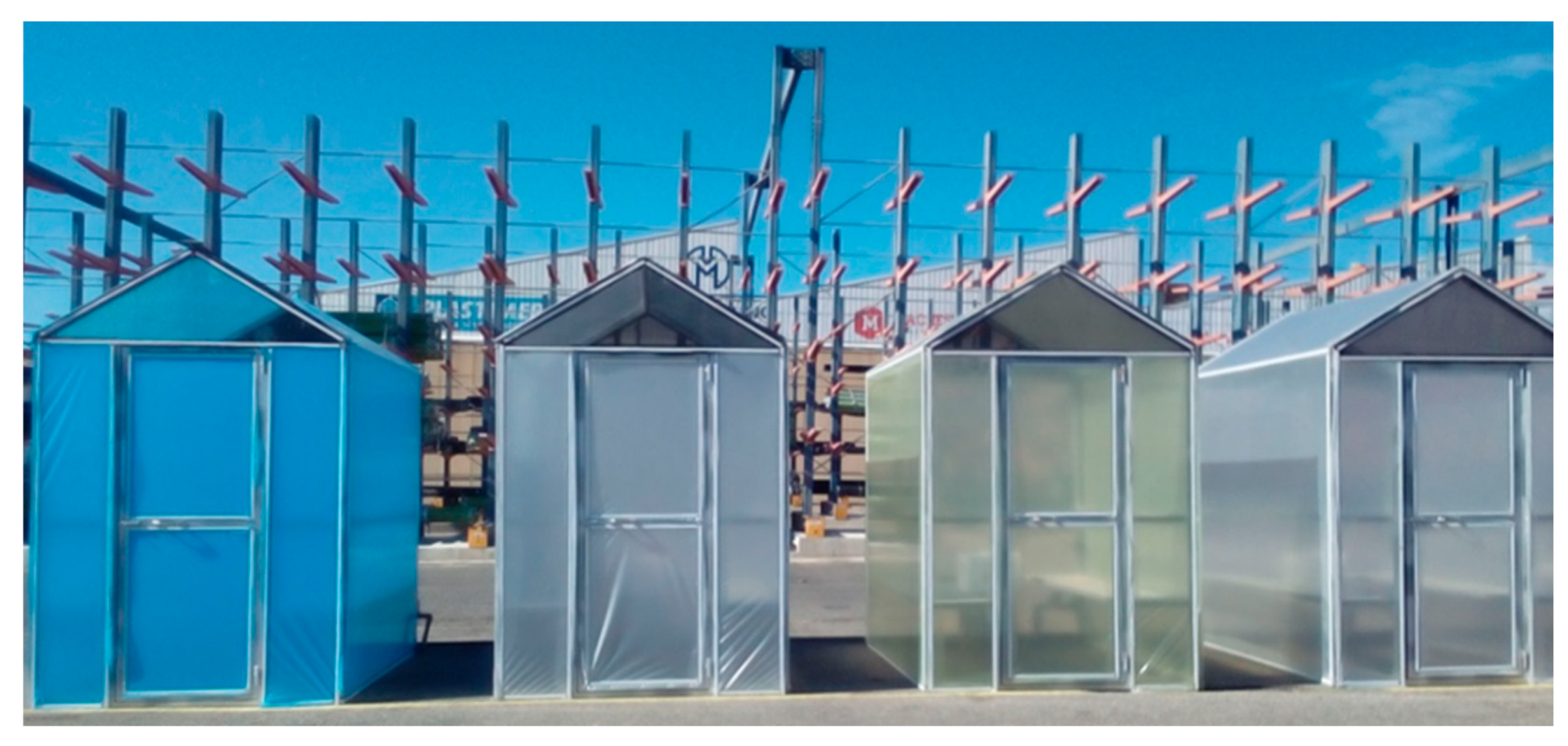
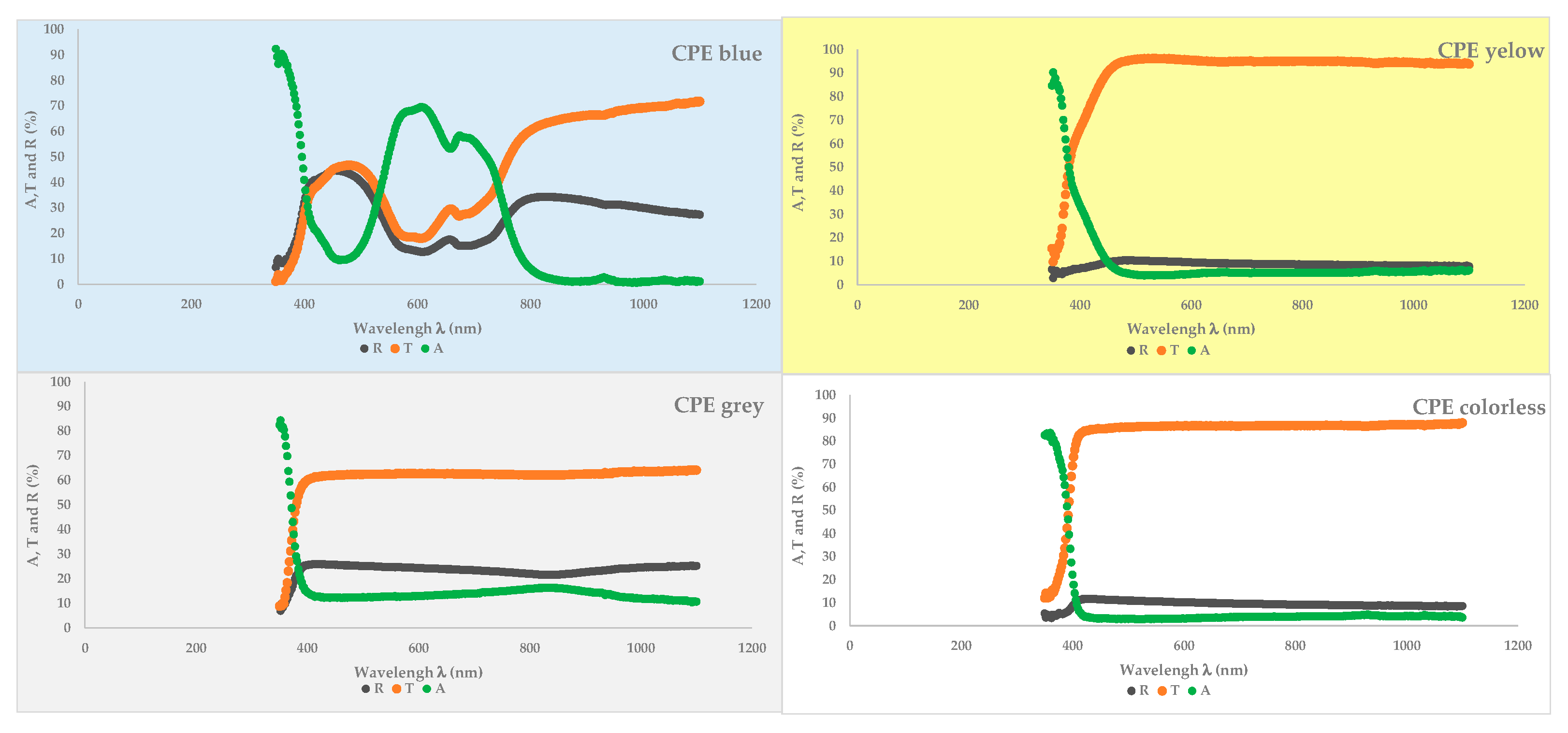

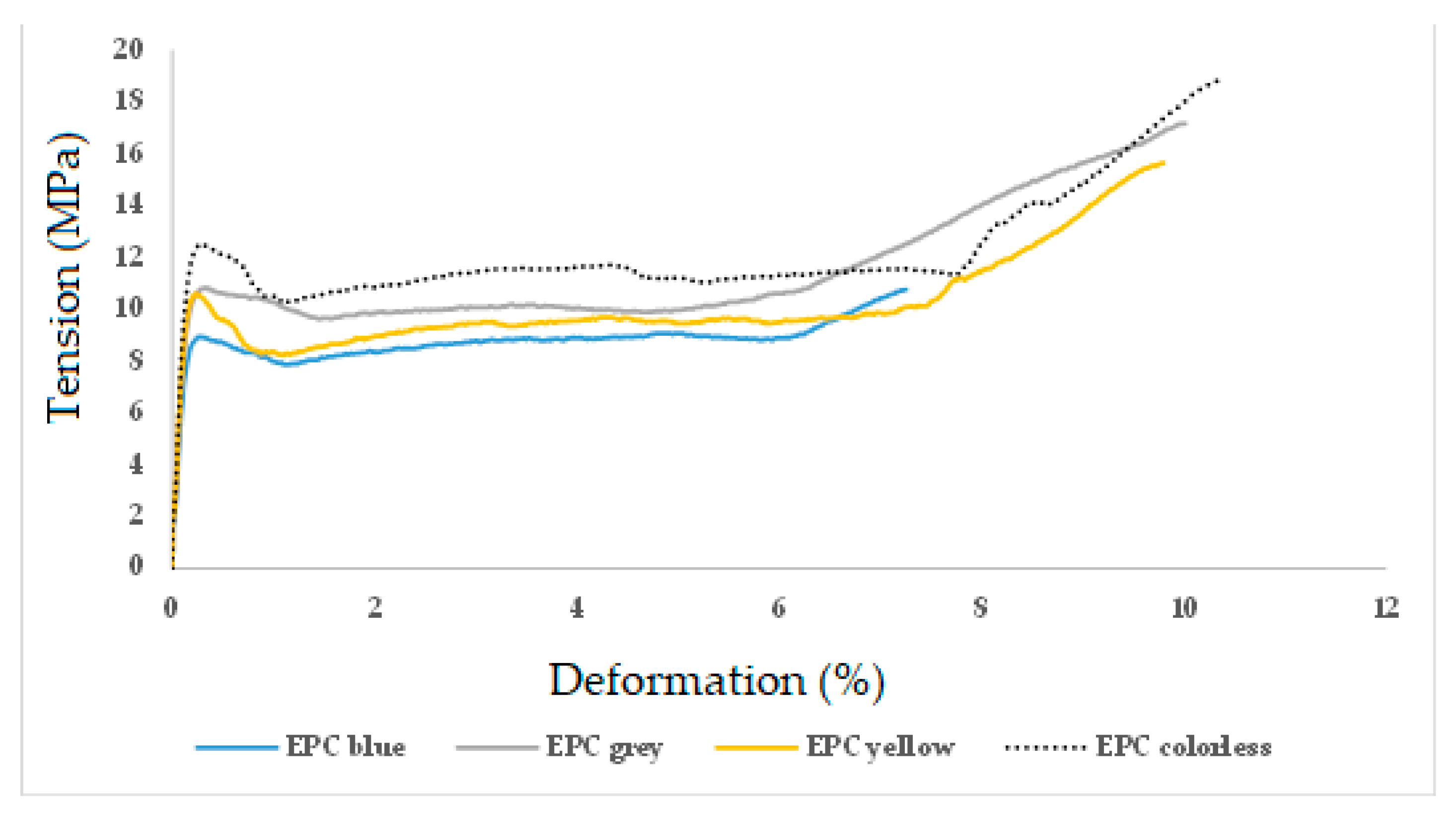
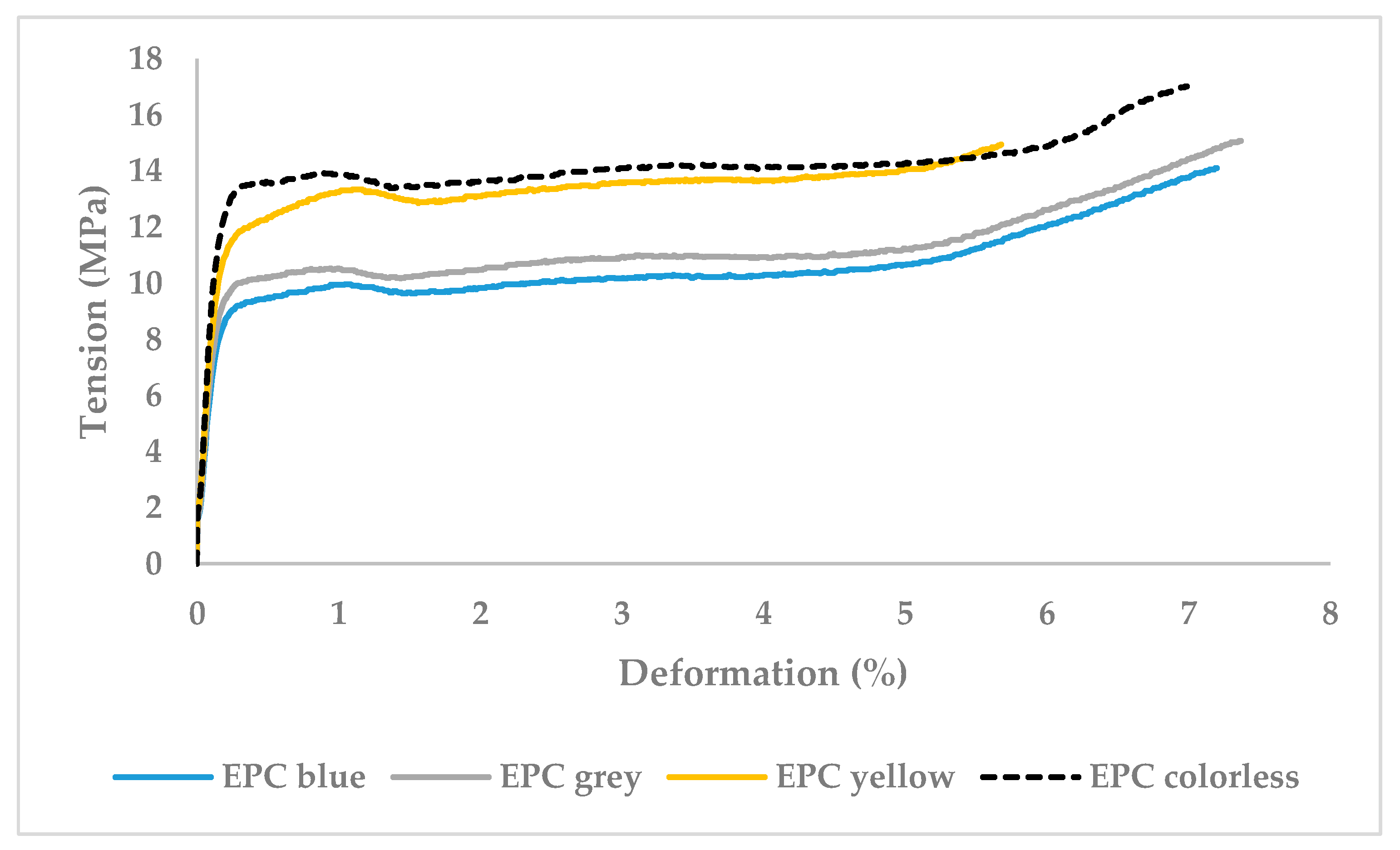
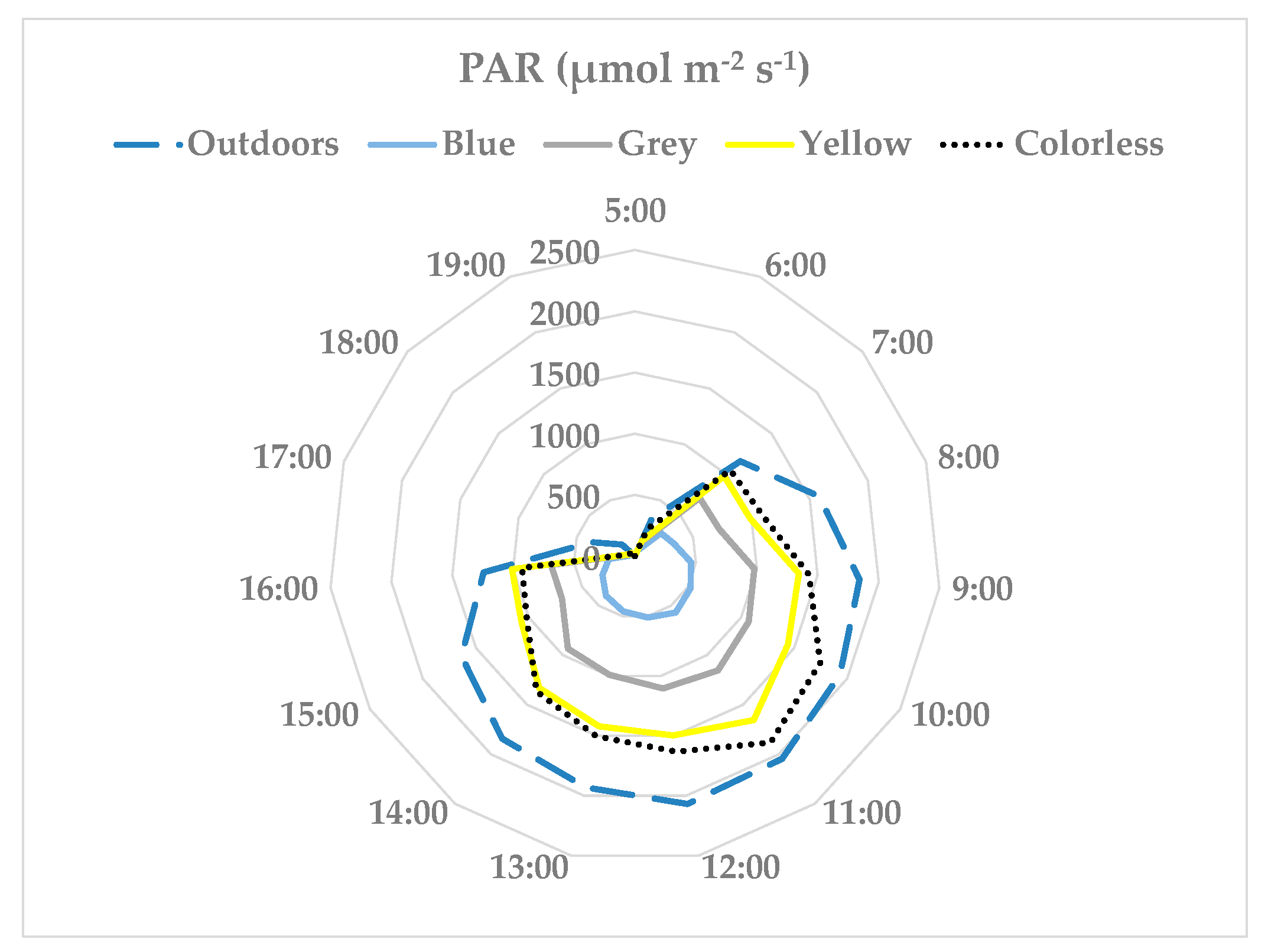
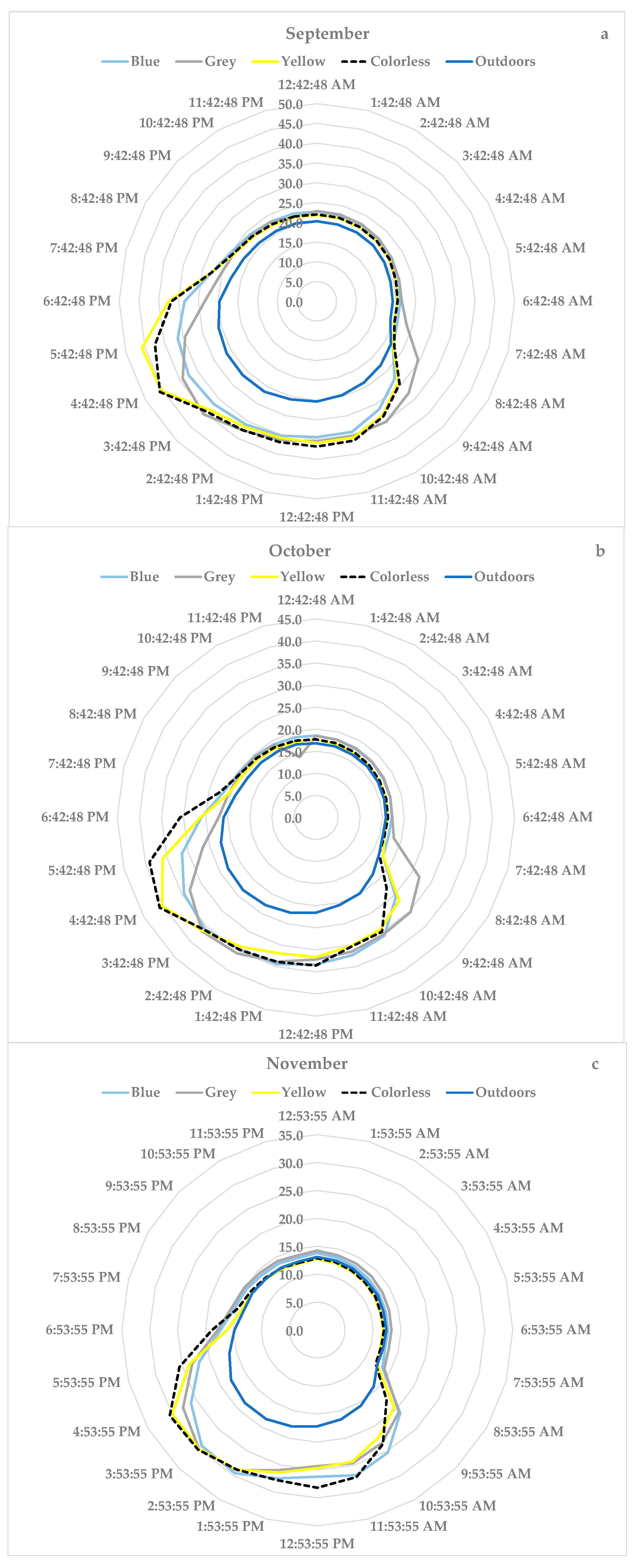
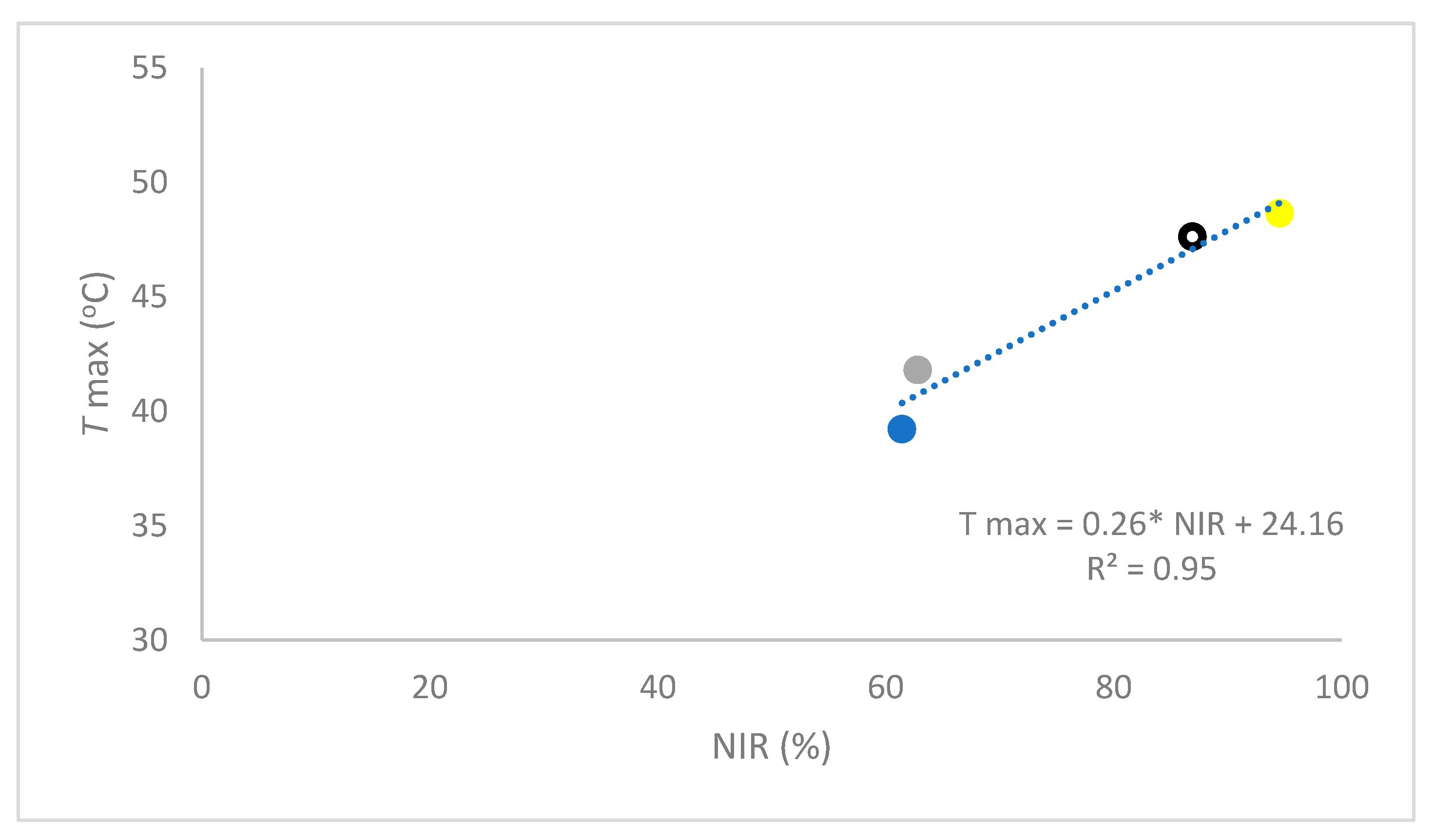
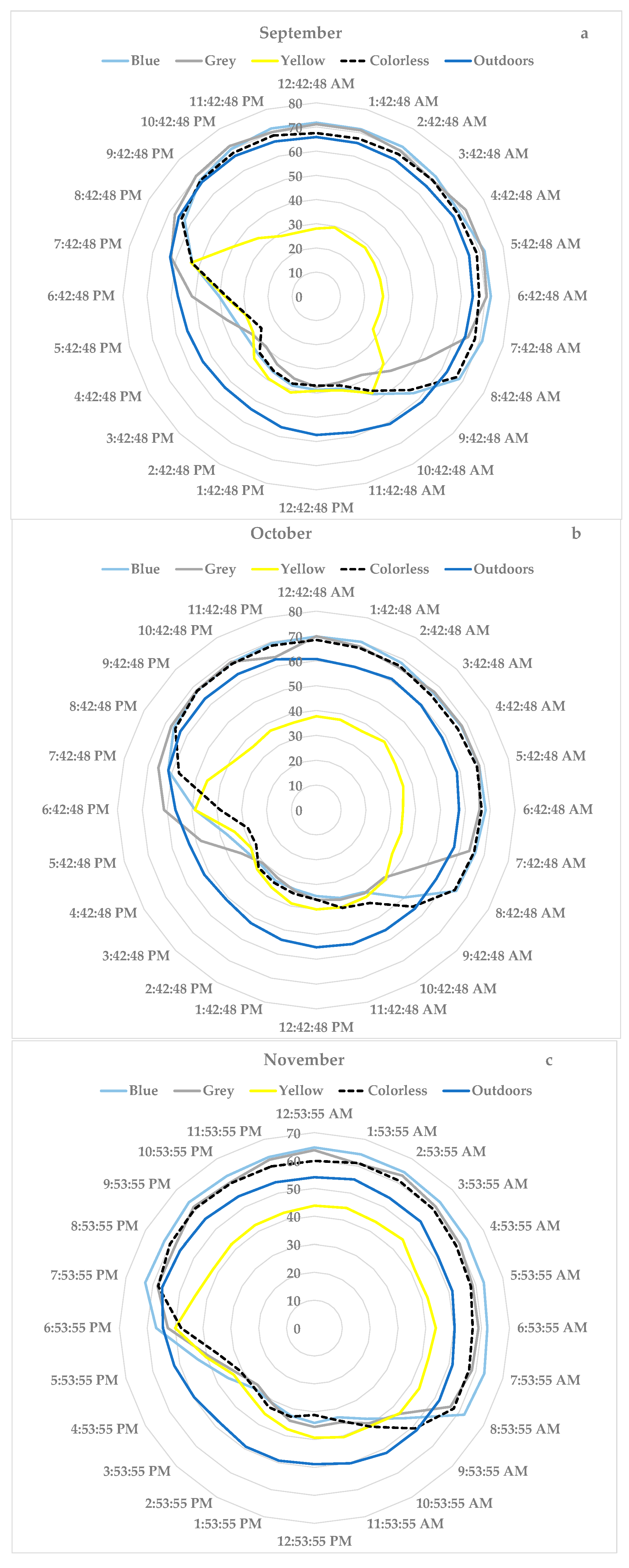
| EPC | Spectral Region (nm) | ||
|---|---|---|---|
| UV-A (350–400) | PAR (400–700) | NIR (700–1100) | |
| Blue | 9.45 | 32.04 | 61.45 |
| Grey | 36.85 | 62.33 | 62.83 |
| Yellow | 38.64 | 92.34 | 94.55 |
| Colorless | 28.11 | 85.77 | 86.93 |
| EPC | Spectral Region (nm) | ||
|---|---|---|---|
| Blue (400–500) | Red (600–700) | Far Red (700–800) | |
| Blue | 42.20 | 24.66 | 44.06 |
| Grey | 61.84 | 62.61 | 62.34 |
| Yellow | 86.42 | 94.91 | 94.88 |
| Colorless | 84.26 | 86.63 | 86.33 |
| EPC | Spectral Regions | ||
|---|---|---|---|
| PAR/NIR | R/FR | B/R | |
| Blue | 0.52 | 0.56 | 1.71 |
| Grey | 0.99 | 1.00 | 0.99 |
| Yellow | 0.98 | 1.00 | 0.91 |
| Colorless | 0.99 | 1.00 | 0.97 |
| EPC | Spectral Region (380–780 nm) |
|---|---|
| Diffusion (%) | |
| Blue | 31 |
| Grey | 40 |
| Yellow | 27 |
| Colorless | 34 |
| EPC | Yield Stress (MPa) | Creep Limit Deformation (%) | Tension in Proportionality Limit (MPa) | Proportionality Limit Deformation (%) |
|---|---|---|---|---|
| Blue | 8.96 | 26.3 | 7.59 | 13.3 |
| Grey | 10.82 | 31.4 | 8.27 | 11.5 |
| Yellow | 10.61 | 22.6 | 7.31 | 8.8 |
| Colorless | 12.53 | 27.9 | 9.59 | 11.4 |
| EPC | Yield Stress (MPa) | Creep Limit Deformation (%) | Tension in Proportionality Limit (MPa) | Proportionality Limit Deformation (%) |
|---|---|---|---|---|
| Blue | 9.97 | 104.6 | 7.94 | 15.1 |
| Grey | 10.54 | 99.7 | 8.84 | 15.7 |
| Yellow | 13.34 | 110.0 | 11.44 | 23.9 |
| Colorless | 13.94 | 89.2 | 12.39 | 19.3 |
| EPC | Maximum Stress (MPa) | Maximum Deformation (%) | Breaking Strain (MPa) | Breakage Deformation (%) |
|---|---|---|---|---|
| Blue | 16.46 | 1058.59 | 16.46 | 1058.59 |
| Grey | 20.08 | 1162.43 | 20.08 | 1162.43 |
| Yellow | 17.56 | 1099.11 | 17.56 | 1099.11 |
| Colorless | 20.589 | 1133.37 | 20.59 | 1133.37 |
| EPC | Maximum Stress (MPa) | Maximum Deformation (%) | Breaking Strain (Mpa) | Breakage Deformation (%) |
|---|---|---|---|---|
| Blue | 15.96 | 846.94 | 15.96 | 846.94 |
| Grey | 17.06 | 872.13 | 17.06 | 872.13 |
| Yellow | 17.56 | 715.44 | 17.56 | 715.44 |
| Colorless | 21.84 | 943.08 | 21.84 | 943.08 |
| EPC | Actual Average Thickness (µm) | Maximum Weight Supported without Breakage (g) | Maximum Weight Reached at the End of the Test (g) |
|---|---|---|---|
| Blue | 219 | 760 | 895 |
| Grey | 213 | 745 | 895 |
| Yellow | 187 | 445 | 490 |
| Colorless | 204 | 490 | 610 |
| EPC | PAR (µmol m−2 s−1) | Transmittance (%) |
|---|---|---|
| Blue | 319.51 | 22.91 |
| Grey | 710.28 | 50.93 |
| Yellow | 997.08 | 71.50 |
| Colorless | 1075.6 | 77.13 |
| EPC | PAR (µmol m−2 s−1) | Transmittance (%) |
|---|---|---|
| Blue | 469.44 | 28.09 |
| Grey | 941.48 | 56.34 |
| Yellow | 1352.38 | 80.93 |
| Colorless | 1387.8 | 83.05 |
| EPC | Average Temperature (°C) | Minimum Temperature (°C) | Maximum Temperature (°C) |
|---|---|---|---|
| Blue | +3.47 | +0.23 | +9.8 |
| Grey | +4.09 | +0.57 | +12.39 |
| Yellow | +4.48 | −0.39 | +19.23 |
| Colorless | +4.36 | −0.61 | +18.21 |
| EPC | Average H.R (%) | Minimum H.R (%) | Maximum H.R (%) |
| Blue | −5.53 | −19.32 | +7.78 |
| Grey | −6.92 | −22.23 | +7.87 |
| Yellow | −7.43 | −25.65 | +2.72 |
| Colorless | −6.92 | −24.83 | +2.88 |
Disclaimer/Publisher’s Note: The statements, opinions and data contained in all publications are solely those of the individual author(s) and contributor(s) and not of MDPI and/or the editor(s). MDPI and/or the editor(s) disclaim responsibility for any injury to people or property resulting from any ideas, methods, instructions or products referred to in the content. |
© 2023 by the authors. Licensee MDPI, Basel, Switzerland. This article is an open access article distributed under the terms and conditions of the Creative Commons Attribution (CC BY) license (https://creativecommons.org/licenses/by/4.0/).
Share and Cite
Franco, J.E.; Rodríguez-Arroyo, J.A.; Jiménez-Lao, R.; Garzón, E.; Lao, M.T. Radiometric, Mechanical and Agronomic Characterization of Four Commercial Polymeric Films for Greenhouse Applications. Appl. Sci. 2023, 13, 13098. https://doi.org/10.3390/app132413098
Franco JE, Rodríguez-Arroyo JA, Jiménez-Lao R, Garzón E, Lao MT. Radiometric, Mechanical and Agronomic Characterization of Four Commercial Polymeric Films for Greenhouse Applications. Applied Sciences. 2023; 13(24):13098. https://doi.org/10.3390/app132413098
Chicago/Turabian StyleFranco, John Eloy, Jesus Antonio Rodríguez-Arroyo, Rafael Jiménez-Lao, Eduardo Garzón, and María Teresa Lao. 2023. "Radiometric, Mechanical and Agronomic Characterization of Four Commercial Polymeric Films for Greenhouse Applications" Applied Sciences 13, no. 24: 13098. https://doi.org/10.3390/app132413098







